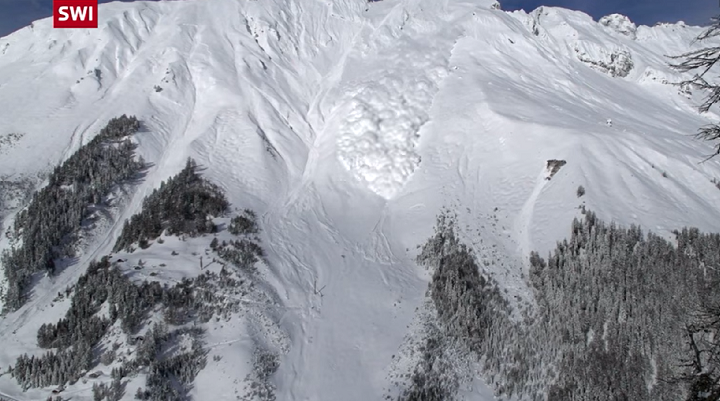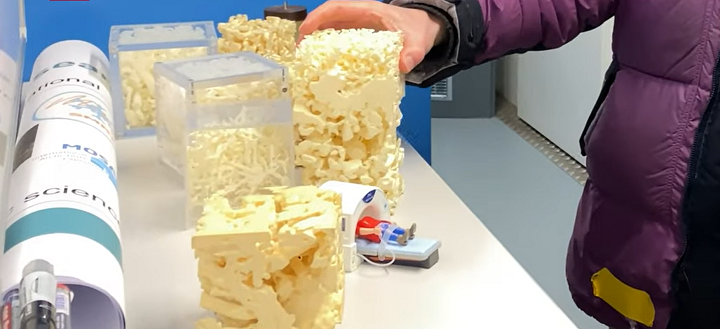In order to better understand how avalanches are triggered, research scientists at a unique cold laboratory in the Swiss Alpine resort town of Davos are scanning and 3D printing cross sections of snow. The models created by the team at the leading WSL-Institut für Schnee- und Lawinenforschung SLF (Institute for Snow and Avalanche Research) are made in order to simulate the effects of wind on freshly fallen snow and thus learn how avalanche-prone snow layers work. This is only the latest in a long line of research projects that use 3D printing to study weather events and natural disasters like asteroids, earthquakes, volcanoes, landslides, and more.
According to National Geographic, a snowpack is layers of snow, ice, and other materials that build up in areas like the side of a mountain, and when their layers slide off, avalanches occur. Snowpacks can be dozens of meters thick, depending on how much snow falls, and their layers have different textures and thicknesses. An avalanche starts when this unstable mass breaks away from a slope. As it rolls downhill, the snow gets faster, picking up more snow as it goes, and produces a fast-moving “river” of snow and an ice particle cloud that rises into the air. A fully developed avalanche can travel faster than 320 km an hour and weigh as much as one million tons, which can lead to a pretty deadly situation.
The SLF, which is part of the Swiss Federal Research Institute WSL and thus in the ETH Zurich domain, was founded in 1936, employs 180 people, and is funded by the Swiss government and project-related third party funds. The interdisciplinary research institute and service center helps resolve urgent social issues, like analyzing environmental and climate changes in mountain areas and warning people of natural hazards in its twice daily Avalanche Bulletin. It also monitors and researches the origin, evolution, and condition of natural hazards, mountain ecological systems, snow, and permafrost, and performs basic and advanced avalanche research, including how they occur and move over terrain.
One of their main objectives in snow research is to determine how it builds up and changes under various conditions, in order to learn how materials like skis can best glide over it, but also how weak layers in a snowpack form and break, causing avalanches. Much of this work happens in the cold lab at the SLF, which is kept at temperatures of -20°C and requires researchers to bundle up before heading inside. Martin Heggli, Media Officer for the SLF, explained in a translated video that they can store snow samples in the lab.
The researchers also make their own snow in one of the lab’s cold chambers, growing snow crystals on nylon threads. They learn how wind transports snow through the use of a wind tunnel. When wind picks snow up and deposits it elsewhere, it can lead to an avalanche, and as Heggli explained, they “want to understand this better, how it works and how the snow moves.” They examine the microstructure of snow with X-ray machines, and while a sample is scanned, it’s also being rotated to generate a 3D image, which is then used to create large 3D prints.
“Here we see that there are very different types of snow, like this one,” Heggli explained. “Here it’s very compact, this is actually ice, and then there is very fine snow. We’re trying to understand how snow changes when layers form. We call this a weak layer, because its mechanics are not very stable. It only takes a little, for example a skier to pass over it, for the load to pass through the snow. Then this layer can break, and the avalanche slides down.”
Professor Johan Gaume, head of the Alpine Mass Movements research unit at the SLF, also has plans that call for 3D printing. His team models mass movements that occur in mountain environments, including rockfalls and avalanches, using 3D models based on the hybrid numerical technique called MPM, or Material Point Method. When asked about his most astonishing scientific result, he explained that it had to do with “crack propagation in snow slab avalanche release.”
“After running simulations at a scale larger than usual, we got surprised: the fracture speed in the weak layer was much larger than any measurements performed so far,” Professor Gaume continued. “We thought we had a problem with our code! But we didn’t and we eventually made sense of what was going. The nice thing is that this result unified conflicting theories with important practical impacts.”
His unit plans to get a large-scale 3D printer to fabricate complex 3D terrain, which will allow them to complete granular flow experiments to gather data for model validation and learn more about granular flows and how they interact with various topographical features.
Subscribe to Our Email Newsletter
Stay up-to-date on all the latest news from the 3D printing industry and receive information and offers from third party vendors.
You May Also Like
Further Understanding of 3D Printing Design at ADDITIV Design World
ADDITIV is back once again! This time, the virtual platform for additive manufacturing will be holding the first-ever edition of ADDITIV Design World on May 23rd from 9:00 AM –...
3D Printer Maker EVO-tech Reborn as NEVO3D — Once More With Feeling
EVO-tech was a 3D printing service and original equipment manufacturer established in 2013 and based in Schörfling am Attersee, Austria. The company produced high-quality material extrusion systems featuring linear bearings,...
3D Systems Brings 3D Printed PEEK Cranial Implant to the U.S. with FDA Clearance
For more than 10 years, 3D Systems (NYSE:DDD) has worked hand-in-hand with surgeons to plan over 150,000 patient-specific cases, and develop more than two million instruments and implants from its...
CDFAM Returns to Berlin for Second Annual Symposium
The second CDFAM Computational Design Symposium is scheduled for May 7-8, 2024, in Berlin, and will convene leading experts in computational design across all scales. Building upon the first event...

































